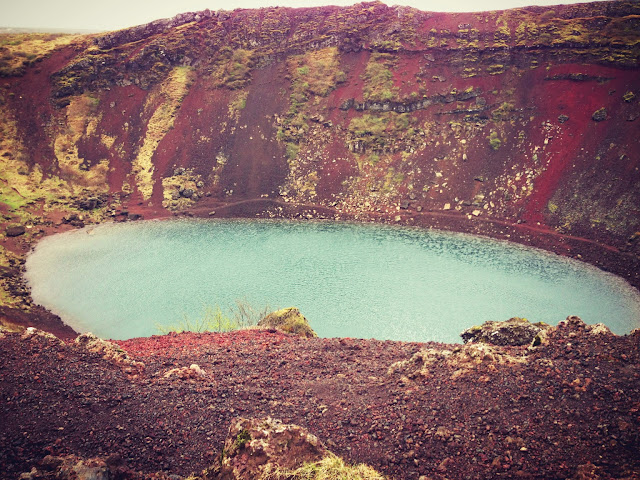Our first stop was at Thingvellir which is the site of a rift valley that marks the crest of the Mid-Atlantic Ridge. It is also home to Þingvallavatn, the largest natural lake in Iceland.
The continental drift between the North American and Eurasian Plates can be clearly seen in the cracks or faults which traverse the region, the biggest one, Almannagjá, being a veritable canyon. This also causes the often-measurable earthquakes in the area.
According to Landnámabók, the settlement of Iceland began in AD 874 when the Norwegian chieftain Ingólfur Arnarson became the first permanent Norwegian settler on the island. Over the next centuries, people of Norse and Celtic origin settled in Iceland.
At Þingvellir the Icelandic Parliament or Alþingi was established in 930 and remained there until 1798. The flagpole on the photo marks the Lögberg (Law Rock) which was the focal point of the Alþingi and a natural platform for holding speeches. The Lawspeaker, elected for three years at a time, presided over the assembly and recited the law of the land.
The present most impressive active "geysir" is Strøkkur, erupting about every 4–8 minutes 15 – 20 m high, sometimes up to 40 m high.
Moving further to the north-east the weather became more and more nice, and for the first time we could see the beauty of the Icelandic landscape and feel the reality of nature.
Next stop was the Gullfoss, a waterfall located in the canyon of Hvítá river.
The waterfalls are really impressive and the volume of water running over this waterfall is 140 m³/s in the summertime and 80 m³/s in the wintertime. The highest flood measured was 2000 m³/s.
Going close to the river may make your cloths wet, but you really feel nature by staying on the edge and see the water falls into a crevice of 32m.
Normally the Golden circle only include the three tourist attractions above.
We had the opportunity to visit two more on our way back to Reykjavik.
First we stopped at Skalholt, one of the most important places in Iceland. From 1056 until 1785, it was one of Iceland's two episcopal sees, along with Hólar, making it a cultural and political center. Iceland's first official school, Skálholtsskóli (now Reykjavík Gymnasium, MR), was founded at Skálholt in 1056 to educate clergy. This is a memorial at Skalholt.
This old bible in the cathedral at Skalholt is from MDLXXXIIII or 1584 if I still can my roman numbers well enough
Before we returned to Hotel Saga in Reykjavik we had a stop at the Kerid volcano. This is an old crater filled with natural rain water. The caldera itself is approximately 55 m (180 ft) deep, 170 m (560 ft) wide, and 270 m (890 ft) across. Kerið’s caldera is one of the three most recognizable volcanic craters because at approximately 3,000 years old, it is only half the age of most of the surrounding volcanic features. The colors on the steep walls tell all about the variety of metallurgical combinations in nature.











2 comments:
For en opplevelse dette må ha vært! Selv i dårlig vær, er Island fasinerende. Flotte bilder!
Takk for jeg fikk "ble med" til et land jeg aldri har besøk.
Fin dag ønskes!
As a decorating and painting business, we realize the importance of delivering a quality service in a timely manner. We will make sure that all your valuables are taken care of and that our work causes minimal disruption to your normal routine. Painters Penrith
Post a Comment